Bio 2 exam questions - Study guides, Class notes & Summaries
Looking for the best study guides, study notes and summaries about Bio 2 exam questions? On this page you'll find 3897 study documents about Bio 2 exam questions.
Page 2 out of 3.897 results
Sort by
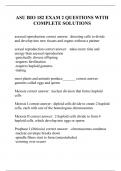
-
ASU BIO 182 EXAM 2 QUESTIONS WITH COMPLETE SOLUTIONS
- Exam (elaborations) • 12 pages • 2023
-
Available in package deal
-
- $11.99
- 4x sold
- + learn more
asexual reproduction correct answer: directing cells to divide and develop into new tissues and organs without a partner sexual reproduction correct answer: -takes more time and energy than asexual reproduction -genetically diverse offspring -requires fertilization -requires haploid gametes -mating most plants and animals produce_______ correct answer: gametes called eggs and sperm Meiosis correct answer: nuclear division that forms haploid cells Meiosis I correct answer: di...
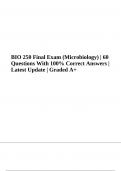
-
BIO 250 Final Exam (Microbiology) | 60 Questions With 100% Correct Answers | Latest Update | Graded A+
- Exam (elaborations) • 22 pages • 2023
- Available in package deal
-
- $22.49
- 6x sold
- + learn more
BIO 250 Final Exam (Microbiology) | 60 Questions With 100% Correct Answers | Latest Update | Graded A+. What microbial process was responsible for changing Earth’s atmosphere from one without oxygen to one with oxygen? Select one: a. anaerobic respiration b. decomposition c. oxygenic photosynthesis d. temperature regulation In the nitrogen cycle, which of the following phases involves the release of nitrogen as into the Earth’s atmosphere? Select one: a. ammonication b. denitrica...
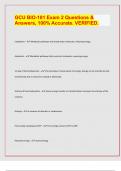
-
GCU BIO-181 Exam 2 Questions & Answers, 100% Accurate. VERIFIED.
- Exam (elaborations) • 10 pages • 2023
-
- $8.49
- 3x sold
- + learn more
GCU BIO-181 Exam 2 Questions & Answers, 100% Accurate. VERIFIED. Catabolism - -Metabolic pathways that break down molecules, releasing energy. Anabolism - -Metabolic pathways that construct molecules, requiring energy. 1st law of thermodynamics - -The principle of conservation of energy. Energy can be transferred and transformed, but it cannot be created or destroyed. 2nd law of thermodynamics - -Every energy transfer or transformation increases the entropy of the universe. Entr...
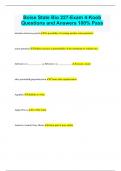
-
Boise State Bio 227-Exam 4-Koob Questions and Answers 100% Pass
- Exam (elaborations) • 30 pages • 2024
- Available in package deal
-
- $10.49
- 1x sold
- + learn more
Boise State Bio 227-Exam 4-Koob Questions and Answers 100% Pass absolute refractory period No possibility of creating another action potential. action potential Sudden increase in permeability of the membrane to sodium ions. Afferent is to ___________ as Efferent is to ___________ sensory, motor after potential/hyperpolarization Comes after repolarization Agraphia inability to write. Alpha Waves 8-13 Hz Calm Anterior (ventral) Gray Horns motor part of gray matter Anterio...
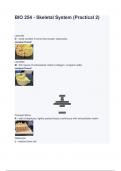
-
BIO 254 - Skeletal System (Practical 2) Exam Questions And Answers
- Exam (elaborations) • 23 pages • 2024
- Available in package deal
-
- $13.99
- 1x sold
- + learn more
BIO 254 - Skeletal System (Practical 2) Exam Questions And Answers Lacunae D - small cavities in bone that contain osteocytes compact bone* Lamellae M - thin layers of extracellular matrix (collagen, inorganic salts) compact bone* Brainpower Read More Previous Play Next Rewind 10 seconds Move forward 10 seconds Unmute 0:00 / 0:15 Full screen Compact Bone K - wall of diaphysis; tightly packed tissue continuous with extracellular matrix Osteocyte L - mature...
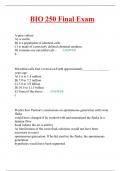
-
Final Exam Straighterline Microbiology 2023/24 TEST BANK
- Package deal • 5 items • 2024
-
- $26.49
- 1x sold
- + learn more
1 Exam (elaborations) Straighterline Microbiology 250 final Exam 2024 Questions and Answers 2 Exam (elaborations) Final Exam Straighterline Microbiology 3 Exam (elaborations) StraighterLine BIO250 - Microbiology Final Exam Study Guide 4 Exam (elaborations) Microbiology 250 Final Exam 5 Exam (elaborations) BIO 250 Final Exam
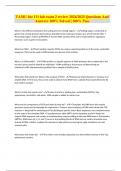
-
TAMU bio 111 lab exam 2 review 2024/2025 Questions And Answers 100% Solved | 100% Pass
- Exam (elaborations) • 8 pages • 2024
- Available in package deal
-
- $10.39
- 1x sold
- + learn more
TAMU bio 111 lab exam 2 review 2024/2025 Questions And Answers 100% Solved | 100% Pass What is the difference between the coding and non-coding region? - Coding region: comprised of genes that encode proteins (instructions that determine traits) and makes up 1-2% of human DNA. • Noncoding region: makes up 98-99% of human DNA, contains STRs and is responsible for regulatory functions such as gene transcription. What are STRs? - Short-tandem repeats (STRs) are unique repeating patterns of ...
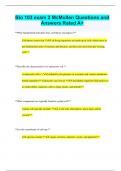
-
Bio 103 exam 2 McMullen Questions and Answers Rated A+
- Exam (elaborations) • 12 pages • 2024
-
- $9.99
- 1x sold
- + learn more
Bio 103 exam 2 McMullen Questions and Answers Rated A+ **What fundamental principles does cell theory encompass?** Cell theory asserts that ** all living organisms are made up of cells, which serve as the fundamental units of structure and function, and that cells arise from pre-existing cells**. **Describe the characteristics of a eukaryotic cell.** A eukaryotic cell is ** defined by the presence of a nucleus and various membrane- bound organelles**. Eukaryotes can exist as ** u...
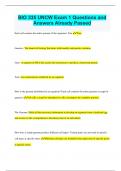
-
BIO 335 UNCW Exam 1 Questions and Answers Already Passed
- Exam (elaborations) • 27 pages • 2024
-
- $9.99
- 1x sold
- + learn more
BIO 335 UNCW Exam 1 Questions and Answers Already Passed Each cell contains the entire genome of the organism: True True Genetics: The branch of biology that deals with heredity and genetic variation Gene: A segment of DNA that carries the instructions to produce a functional protein Trait: Any characteristic exhibited by an organism How is the genome distributed in an organism? Each cell contains the entire genome (except for gametes) All cells, except for reproductive cells, encompass t...
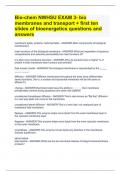
-
NWHSU Exam Bundle with Complete Solutions (100% Pass)
- Package deal • 21 items • 2024
-
- $30.49
- 1x sold
- + learn more
Exam (elaborations) Bio-chem NWHSU EXAM 3- bio membranes and transport + first ten slides of bioenergetics questions and answers Exam (elaborations) Biochemistry 1 Exam 1 NWHSU Questions with Latest Update Exam (elaborations) GIGU- NWHSU- GIGU Final Review Exam Questions with Complete Solutions Exam (elaborations) Methods 2 Midterm- NWHSU Ex

How did he do that? By selling his study resources on Stuvia. Try it yourself! Discover all about earning on Stuvia


